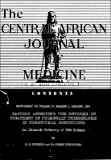| dc.contributor.author | Drake, D.J. | |
| dc.contributor.author | Blair, A.W. | |
| dc.coverage.spatial | Zimbabwe (formerly Rhodesia.) | en_GB |
| dc.date.accessioned | 2014-11-04T11:37:34Z | |
| dc.date.available | 2014-11-04T11:37:34Z | |
| dc.date.issued | 1971-05 | |
| dc.identifier.citation | Drake, D. J. & Blair, A.W (1971) Meningitic Anthrax, CAJM vol. 17, no.5. Harare (formerly Salisbury), Avondale: CAJM. | en_GB |
| dc.identifier.issn | 0008-9176 | |
| dc.identifier.uri | https://opendocs.ids.ac.uk/opendocs/handle/20.500.12413/4997 | |
| dc.description.abstract | Anthrax in humans in many parts of the world is largely an occupational disease and is acquired by entry of the infecting agent through the cut or abraded skin or by inhalation of dusts containing sufficient numbers of spores. The cutaneous type in such circumstances is by far the commonest; pulmonary, anthrax is much less common. Described cases of anthrax meningitis are few. This would at first seem surprising, as the disease in animals is so often and dramatically septicaemic, but is probably accounted for by the fact that the organism is less pathogenic to man than to animals.
This paper presents brief clinical details of a case of anthrax meningitis who came under the clinical care of one of us (D.J.D.). | en_GB |
| dc.language.iso | en | en_GB |
| dc.publisher | Central African Journal of Medicine (CAJM), University of Zimbabwe (formerly University College of Rhodesia.). | en_GB |
| dc.rights.uri | http://creativecommons.org/licenses/by-nc-nd/3.0/ | en_GB |
| dc.subject | Health | en_GB |
| dc.title | Meningitic Anthrax | en_GB |
| dc.type | Article | en_GB |
| dc.rights.holder | University of Zimbabwe | en_GB |


